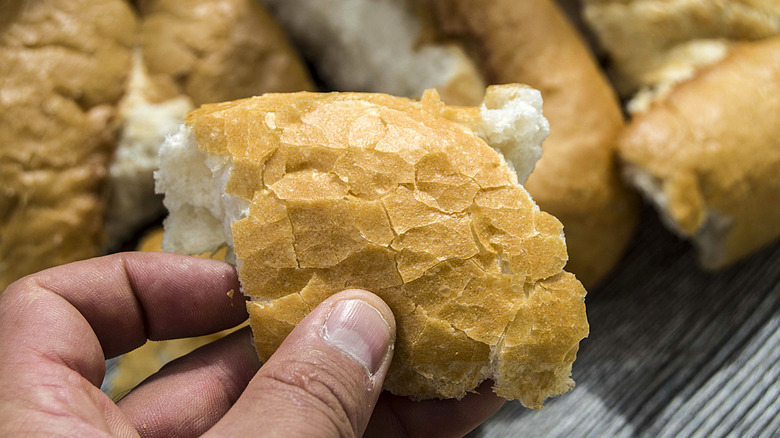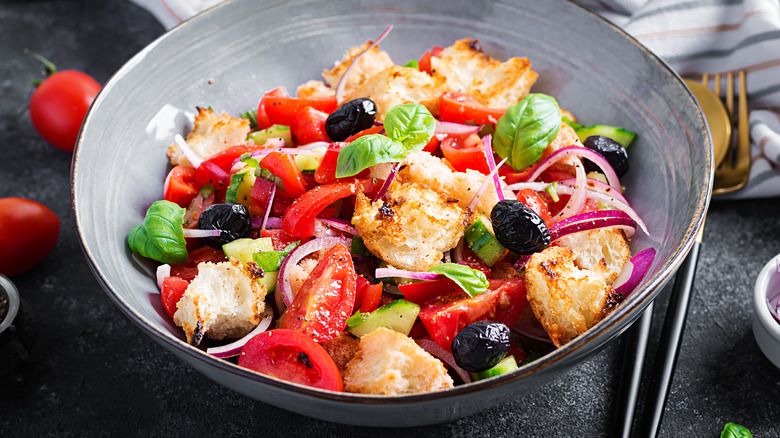Turn Stale Bread Into A Deliciously Hearty Soup
Stale bread is a pretty commonplace situation in the kitchen. It usually happens pretty quickly, especially with freshly-made, artisan loaves that aren't baked with preservatives. Even though these are, arguably, the best-tasting loaves, sometimes we can't get through the entire thing in one sitting (but we do try, don't we?). Unless you freeze the leftover bread like Ina Garten does, by the next day it's usually on its way to turning stale. This doesn't mean it's time to throw it in the trash, however. Take a cue from the Europeans, where so much of the cuisine is based on centuries of peasant food that utilized every resource, and turn your leftover bread into tonight's meal.
The cuisine of the Tuscany region of Italy is very rooted in this kind of resourcefulness. To this day, dishes remain heavy on affordable ingredients like seasonal produce, beans, local game, and lots of bread. One of Tuscany's most famous dishes is called ribollita soup, a delicious, hearty mix that happens to be thickened with stale bread. There are several versions of it, with some being super brothy and others so thick that you could stand a spoon upright in it. Usually, though, the recipe contains cannellini beans and vegetables (though even the type of veggies can vary based on what is available). Yet, bread is always an essential component.
How is ribollita made?
The word ribollita translates to "reboiled" in English, and the name of the dish describes precisely how it's prepared: it's boiled (or simmered) twice before it's eaten. It begins the way many soups do, with aromatics like onion, carrots, and celery sautéed in olive oil. Garlic is then added, followed by liquid such as a vegetable or chicken stock, and flavoring in the form of herbs such as rosemary, thyme, and bay leaves. Some recipes call for a Parmigiano Reggiano cheese rind to be added at this point for enhanced flavor. All of it comes to a boil and simmers for about 20 minutes.
Next, cannellini beans and any other vegetables being used are added. These can include kale (traditionally, Tuscan kale or cavolo nero), cabbage, Swiss chard, potatoes, tomatoes, zucchini, and escarole. At this point is also when the bread is added to the mix. Because it's added to a liquid, it doesn't matter if it's stale (which is why it's a great way to use leftover loaves). Some recipes even call for it to be drizzled with olive oil and baked for 10 minutes before being added to the soup. Also, depending on the recipe, the bread may be sliced, cubed, or in chunks.
Once the bread is in, the soup is boiled again until the vegetables are soft and the bread breaks down, making the mix thick. In many Italian homes, the reboiling part is actually done the next day, allowing flavors time to meld together.
Other ways you can use stale bread
Ribollita is hardly the only dish to make from leftover, stale bread. There's of course the option of making croutons and bread crumbs. Several other Italian recipes, in fact, offer more applications. Stale bread is used in another soup called acquacotta, translating to "cooked water." This is also a dish that originated in Tuscany and combines water, onions, bread, and whatever vegetables that happen to be available. Similar to ribollita, in acquacotta, the bread gives the soup substance and heartiness. Another Tuscan dish that uses bread as a main ingredient is pappa al pomodoro. It's more tomato-heavy than the other two, and when it's finished, looks like a very thick tomato soup.
Often a popular summertime pick, panzanella is an Italian salad made with chunks of stale or dried bread, fresh tomatoes, basil, and a vinegar-based dressing that gets deliciously absorbed into the bread pieces. Sometimes, other ingredients are added to the mix as well, like onions, cucumbers, and cheese.
Clearly, Italy has mastered the art of using stale bread, but there are plenty of other countries that have their own way of utilizing the leftover carb. There's Middle Eastern fattoush (aka "bread salad"), French onion soup, and even American fare like sheet pan chicken served over roasted bread cubes. Indeed, unless it's gone moldy, there's always something you can do with bread, even if it seems past its prime.



